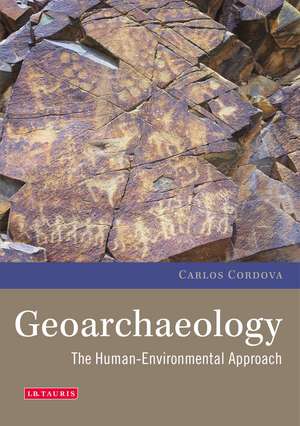Geoarchaeology: The Human-Environmental Approach: Environmental History and Global Change
Autor Carlos Cordovaen Limba Engleză Paperback – 19 feb 2020
Preț: 227.51 lei
Preț vechi: 290.33 lei
-22% Nou
Puncte Express: 341
Preț estimativ în valută:
43.53€ • 44.91$ • 36.33£
43.53€ • 44.91$ • 36.33£
Carte tipărită la comandă
Livrare economică 27 martie-10 aprilie
Preluare comenzi: 021 569.72.76
Specificații
ISBN-13: 9780755606771
ISBN-10: 0755606779
Pagini: 320
Ilustrații: 88 b/w integrated
Dimensiuni: 172 x 244 x 27 mm
Greutate: 0.51 kg
Editura: Bloomsbury Publishing
Colecția I.B.Tauris
Seria Environmental History and Global Change
Locul publicării:London, United Kingdom
ISBN-10: 0755606779
Pagini: 320
Ilustrații: 88 b/w integrated
Dimensiuni: 172 x 244 x 27 mm
Greutate: 0.51 kg
Editura: Bloomsbury Publishing
Colecția I.B.Tauris
Seria Environmental History and Global Change
Locul publicării:London, United Kingdom
Notă biografică
Carlos Cordova is Professor of Geography, Oklahoma State University. He obtained his PhD at the University of Texas, under the supervision of Karl Butzer. He has undertaken geoarchaeological research in the North America, Mexico, the Middle East, Southern Africa, and Crimea and the Black Sea Region and is the author of Crimea: An Environmental History (I.B.Tauris, 2016) and Millennial Landscape Change in Jordan: Geoarchaeology and Cultural Ecology (2007).
Cuprins
List of figuresList of tablesIntroduction Chapter 1 The nature of geoarchaeology The nature of geoarchaeology and its practitionersThe three major traditions in geoarchaeologyThe field and its status in and outside sciencePractice, training, and rapidly evolving subfieldsChapter 2 Theoretical and methodological foundationsIntroductionTheory in geoarchaeologyThe geoarchaeological methodModels of inquiry and interpretationReconstructing the pastThe explanation of a complex and chaotic worldConcluding remarksChapter 3 The geoarchaeological record: Concept and contextsAn epistemological backgroundAn all-inclusive geoarchaeological recordThe contextual levels: site, setting, landscape and environmentModels of interpretationChapter 4 The geoarchaeological record: Interpretation issuesVisualizing time, causality, and contextCausality in natural and cultural transform processesTime-transgressive phenomena and multi-causal effectsArchaeological visibility, invisibility, and absenceThe virtues of off-site geoarchaeologyLegacy effects, relicts, and palimpsestsModern analogs, reference analogs, and modern referencesSampling and interpretation of the recordCorrelation and its issuesChapter 5 The human-environmental tradition in geoarchaeology IntroductionThe ecological paradigm The ecological context in geoarchaeologyGeoarchaeology after Archaeology as Human EcologyThe rise of the Anthropocene and global climate changePerspectives on the anthropic and non-anthropic worldsGeoarchaeology and environmental historyChapter 6 Geoarchaeology and human evolutionIntroductionGeology, climate changes, and biogeographyGeoarchaeology in paleoanthropological researchContextual and issues Case 6.1 Context and scale in the Olduvai hominin recordChapter 7 Geoarchaeology and the anthropization of the world IntroductionThe proto-anthropic period as a gray zoneGeoarchaeology and the pre- and proto-anthropic periodsCase 7.1 Between paleontological and archaeological sites: Geoarchaeological issues in Pre-Clovis mammoth localitiesCase 7.2 The geoarchaeology of early Australian human environments at Lake MungoChapter 8 The geoarchaeology of hunter-gatherer landscapesIntroductionHunter-gatherer societies and their environmental contextsGeoarchaeological approaches to hunter-gatherer landscaapesCase 8.1 Epipaleolithic hunter-gatherers of the Eastern Levant. Sites, settings and landscapes in a rapidly changing environmentCase 8.2: The geoarchaeology of the Archaic period in the Great Plains of North AmericaChapter 9 The record of early agriculture and its diffusion IntroductionAgricultural beginnings: Contextual modelsNeolithic impacts at different scalesGeoarchaeological context and research strategiesCase 9.1 Geoarchaeology of two Near Eastern Neolithic settlements: Ain Ghazal and Ain Abu-Nukhaila, and the first agricultural environmental crisisCase 9.2 The elusive environmental impact of the arrival of pastoralism in Southern Africa.Chapter 10 Complex societal-environmental systems and the collapse phenomenonIntroductionComplex societal-environmental systemsThe rise and collapse phenomenonResearch contextsCase 10.1 Ancient sustainability, risks, management, and centralization in large river basins: Three examples.Case 10.2 The Classic Maya collapse and the degradation of soils in the Maya lowlands: Geoarchaeological models of landscape transformation.Chapter 11 The geoarchaeology of rural landscapesIntroductionThe rural landscape: concepts and environmental approaches Geoarchaeological strategies in rural contextsCase 11.1 The Ancient Greek rural landscape of CrimeaCase 11.2 Xaltocan: The geoarchaeology of a complex lacustrine society before Tenochtitlan. Chapter 12 Human-environmental approaches to soils and paleosolsIntroductionThematic approaches to paleosolsThe




